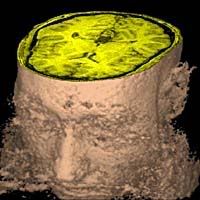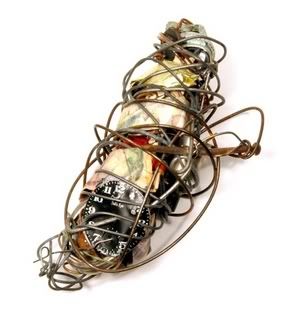Tuesday, June 20, 2006
Scale and Time On My Mind
I imagine many readers are already familiar with "The Powers of Ten," the simple, but profound short film produced by Charles and Ray Eames, of Eames design fame.
A few weeks ago, I posted "Vultures," a poem by Mary Oliver. As a throw away lead-in, I suggested that the poem could effectively replace my artist statement, communicating the ideas that I always write around. The subject of "Vultures," like so much of Oliver's work, is the rather messy process of "resurrection" via recycling (or what I prefer to term "reconstitution"). I die today to sustain that which will be tomorrow.
I've long been fascinated by death, compost, and their associated sauces. Much of my writing reflects this interest, but only rarely have I written about issues of scale. Initially scale and resurrection may seem disparate matters, but I believe that infinite regression, or travel within, leads to infinite progression, or travel without. Similarly, the reduction (or the extinguishing) of one life leads to another, new one (or many). With this in mind, "The Powers of Ten" is powerfully resonant.
Riffing on this idea, I recommend a listen to a recent episode of RadioLab. In it, co-host Jad Abumrad interviews Ann Druyan, Carl Sagan's widow and, along with him, one of the creators of the Voyager golden record, which I wrote about at some length here.
If you have some time to kill, watch "The Powers of Ten," and then listen to the RadioLab episode. They make for an exciting combo, and the Radiolab episode reaffirmed my belief that the golden record is "the culmination of modern art." What an arrogant, absurd, beautiful gesture?!
Monday, June 19, 2006

Once again, I find myself ignoring Hungry Hyaena in favor of painting and drawing. To be fair, "ignore" isn't really the appropriate word. I miss the regular writing terribly and, even when happily ensconced in the studio, I find myself fretting about the difficulty of achieving equipoise. Is it possible to fully satisfy two creative motivations? The writing complements the painting, to be sure, but both require a great deal of time (and hand-wringing) and are, therefore, competitive with one another. Occasionally, I'm able to steal a few minutes from the day job - as I'm doing presently - but I prefer to spend hours turning over a piece of writing and these cursory, apologetic posts are totally unsatisfying...even frustrating.
In the blogosphere, a few of these "I'm still alive!" proclamations in a row typically suggests flagging interest on the part of the writer. I assure you this isn't the case. I just need one of those handy, magic remote controls, like the one featured in the new Adam Sandler comedy, "Click" (which looks truly awful). Wouldn't it be nice to press the "Pause" button, bang out a dozen paintings and thirty essays while everything else is frozen, and then hit "Play." Oh, to be that prolific without sacrificing care!
At any rate, with several shows coming up in the fall, I need to make more art work, stat. Although I already have plenty of work on hand, I'm spread a little thin due to the overlapping exhibition timeline. So, until the fall arrives, I fear posts will remain infrequent.
Further troubling on the writing front is the unsettled situation at Scrawled. v1n5 (the June issue) has yet to appear online and, at the moment, I'm not sure it ever will. I'm in the process of trying to find another art magazine - online or otherwise - to publish with on a semi-regular basis. Whatever the case, I'll definitely let HH readers know when and where the piece on artist Deborah Simon will appear...when it does. Also on the horizon is a feature on the work of Sarah Trigg.
Alright, a few random things I thought I'd mention.

1) On Friday afternoon, I learned that the human male brain matures at 30 years of age. (By contrast, the female brain is mature at 22.) I can't stress enough how relieved I was upon hearing this. I cheered the year-and-a-half of my remaining, relative adolescence. Party on, Wayne! But then I wondered: should I despair that there will, after maturity, be no physical expansion or further connectivity? Oh, well. Sure, I'll have to make do with a lot of fine-tuning, but - let's be honest - it will be wonderful to sort out the mess.

"untitled"
c. 1970
Mixed media
7 x 3 1/2 x 2 1/4 inches
2) On Saturday, while taking a much needed break from painting, I read the most recent issue of ArtForum (Summer 2006). The closing lines of Jenifer P. Borum's review of the Philadelphia Wireman at Matthew Marks rankled me.
Borum writes, "...the question remains: Can or should the Wireman's appropriation of pop-cultural castoffs, produced without any apparent ironic or other critical intent, ever be assigned the same art-historical significance as the work of more canon-savvy practitioners?"
Because Borum focuses on "art-historical significance," I almost forgave the question, but her description of "canon-savvy practitioners" stinks of Art World pretension. Is thoughtful art produced only by a trained, privileged caste? For that matter, need art be thoughtful - as in intellectually stimulating - to be valuable to the maker? I, too, question what, if anything, distinguishes the Philadelphia Wireman's assemblages from the objects produced by innumerable other unrecognized - or under recognized - artists working outside the Art World proper, but Borum's query is more general and divisive. In essence, she asks if any of these "outsiders" is significant.
In response, I ask Borum. What real world significance is assigned to the ironic and critical work of canon-savvy practitioners? For the Philadelphia Wireman and many thousands of other working artists - whether or not they make a living at their craft - the making is definitive. The Philadelphia Wireman probably harbored no illusions of gallery exhibitions or critical bibliographies; for him, the bending and the stuffing and the tying was a curious way to pass - maybe even measure - time. Nothing more, but what more is there? Bollocks to art-historical significance. It will all be redefined (and then erased) in any event.
3) Lastly, on Sunday morning a friend emailed me a video featuring the amazing visual acuity of Steven Wiltshire. (More info here.) Wiltshire suffers from autistic spectrum disorder. He was mute until the age of 9, and his primary mode of communication during the early years was drawing. Although he does talk now, drawing remains central to his life. His architectural renderings are accomplished and he produces them very quickly, with little or no editing. Most remarkable, however, is his ability to observe a scene and then draw it, from memory, almost perfectly. This sounds hard to believe, but I encourage anyone interested in neuroscience or art to check out the video. I was flabbergasted.
Photo credits: ripped remote image from Amazon.com; ripped brain image from www.mabot.com; Philadelphia Wireman image courtesy Matthew Marks Gallery
Monday, June 05, 2006
Reading Mary's Vultures
When I'm in the midst of a studio surge, essay ideas often gestate for months. Jotted notes and fragmented Word documents evidence my intention to write, but I find it difficult to commit. Reading, by contrast, remains an essential activity during these periods and, curiously, poetry often trumps prose, perhaps because it is more like visual art, more open and sensuous.
I've recently been enjoying collections of Mary Oliver and Czeslaw Milosz. Much of Oliver's work compliments my own. Reading her poems, I feel a reciprocated embrace; she often channels a wonderful existential experience. Frankly, if I could get away with submitting "Vultures" as my artist statement, I'd happily do so!
Photo credit: "Soaring," painted by Andrew Wyeth (photograph by Ken Burris, for Shelburne Museum)
I've recently been enjoying collections of Mary Oliver and Czeslaw Milosz. Much of Oliver's work compliments my own. Reading her poems, I feel a reciprocated embrace; she often channels a wonderful existential experience. Frankly, if I could get away with submitting "Vultures" as my artist statement, I'd happily do so!
VulturesDeceptively straight-forward, the poem will open, for readers of a certain disposition, to complex interpretation. For me, "Vultures" is an insightful tracing of a complicated relationship with religion and a paean to the contemplation of death and awesomeness of the universe's messy abundance.
Like large dark
lazy
butterflies they sweep over
the glades looking
for death,
to eat it,
to make it vanish,
to make of it the miracle:
resurrection. No one
knows how many
they are who daily
minister so to the grassy
miles, no one
counts how many bodies
they discover
and descend to, demonstrating
each time the earth’s
appetite, the unending
waterfalls of change.
No one
moreover,
wants to ponder it,
how it will be
to feel the blood cool,
shapeliness dissolve.
Locked into
the blaze of our own bodies
we watch them
wheeling and drifting, we
honor them and we
loathe them,
however wise the doctrine,
however magnificent the cycles,
however ultimately sweet
the huddle of death to fuel
those powerful wings.
Photo credit: "Soaring," painted by Andrew Wyeth (photograph by Ken Burris, for Shelburne Museum)
Subscribe to:
Comments (Atom)
